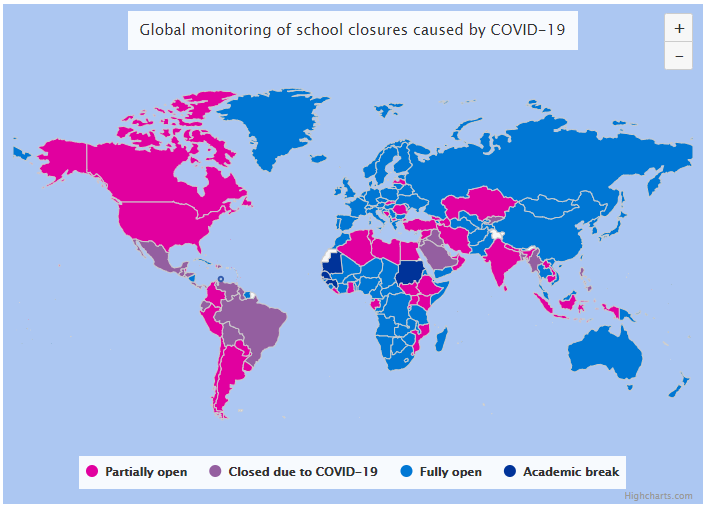
With the world facing many challenges from the 2020 pandemic, the education sector of society comes to mind as one of the biggest overnight transformations. Covid-19 has disrupted the school system in a variety of ways in order to contain the spread of the virus. 87% of the world’s student population has been affected by school closures. Now, educational institutions have transitioned from traditional learning to remote learning or hybrid class settings through phases. This has created an array of obstacles for many children and their families.
From Classrooms to Computers
For some youth, being at home doing schoolwork is ideal, while for others it is challenging. Remote learning has allowed students to do schoolwork in the comfort of their home while still completing their education requirements. However, students in at-risk populations do not always have the proper resources or parental support to complete their course load and this can lead students struggling to cope with this “new normal” learning environment.
The transformation to remote learning also has an economic impact on families. Students from low-income families are most likely to be left behind. The Hechinger Report acknowledges that children in families who have a household income of less than $25,000 are 10 times less likely to participate in remote learning than other children. Moreover, this group of students is also 3 times more likely to not have access to technological devices for their schoolwork. Without the proper resources to complete their learning, students will fall behind not only academically but also in their fundamental skills. Additionally, students are not able to socialize with their peers through remote learning. According to the eLearning Industry, 55% of students are still struggling with the lack of social interaction and find that they learn better when around other students. Consequently, the lack of socialization can lead to 45% of students underperforming in their academics.
On another note, adolescents are not the only ones affected by this change, but teachers are also. Teachers all over the world had to adjust to new learning styles and overcome technological difficulties. With the sudden change from face-to-face learning, the majority of schools and teachers found themselves unprepared. Teachers have found new creative ways to engage their students and help provide resources. Most teachers meet with their students online via systems like Zoom, Skype, or Microsoft Teams.
Pictured is a map of school closures around the world impacted by COVID-19.
Effects of Virtual Environments
Virtual environments were integral to the shift of remote work and education. However, a completely virtual world has come with drawbacks, especially in the youth and child welfare system.
The fact that school is conducted virtually- has caused a drop in child abuse and neglect reports in the United States. While this may sound appealing, it is quite the opposite. Since education professionals are the primary reporters of child maltreatment, virtual environments have made it harder than ever for them to detect troubling signs. Back in March, Wisconsin, Oregon, Pennsylvania, and Illinois saw reports of child abuse fall between 20% and 70%. Many factors from the pandemic have contributed to the increase of child abuse like, youth being kept away from school, nearly 10 million Americans who are unemployed, and the added stress from isolation. Brookings explains that there is evidence that during economic hardship, an increase in child maltreatment occurs. With many schools operating virtually until further notice, it is important to raise the concern of child abuse and to find creative ways to get the community involved.
How MST is Coping During the Pandemic
Multisystemic Therapy (MST) continues to deliver services during the COVID-19 pandemic through social distancing and telehealth methodologies such as telephone and/or video-based options. As an evidence-based practice, MST provides better outcomes for youth without the risk of infection in a facility environment.
"Families experiencing social isolation may be at particular risk for mental health problems and escalated domestic situations. These families need to be able to continue with MST and not be relegated to a lower level of service during this crisis," said Keller Strother, Co-Founder of MST Services.
Multisystemic Therapy (MST) is an evidence-based program for at-risk youth and families. MST is a community-based program for juveniles that helps prevent youth violence by utilizing a built-in suite of services within the home, school, and community settings. Services include but are not limited to: social skills training, drug, and alcohol intervention, mental health services, and peer management.
If you would like to learn more about how MST Services is operating during Covid-19, please click here.


